REVIEW ARTICLE
Beyond Patient Safety Goal Towards Hospital Sustainable Risk: A Systematic Review on the Evolution of Hospital Risk Management
Patipan Sae-Lim1, *, Sirintata (Pongpech) Singhara Na Ayudhaya2
Article Information
Identifiers and Pagination:
Year: 2024Volume: 17
E-location ID: e18749445284229
Publisher ID: e18749445284229
DOI: 10.2174/0118749445284229240313062944
Article History:
Received Date: 17/11/2023Revision Received Date: 05/02/2024
Acceptance Date: 20/02/2024
Electronic publication date: 21/03/2024
Collection year: 2024

open-access license: This is an open access article distributed under the terms of the Creative Commons Attribution 4.0 International Public License (CC-BY 4.0), a copy of which is available at: https://creativecommons.org/licenses/by/4.0/legalcode. This license permits unrestricted use, distribution, and reproduction in any medium, provided the original author and source are credited.
Abstract
Background
Risk management is an indispensable tool in every business sector, yet the aspects of it are various given the business types. The hospital industry employs risk management as a day-to-day operation, but most of the time, risk management to them is related to only patient safety. In this study, our team hypothesized if there are any other aspects of hospital risk management from the research landscape.
Objective
In this manuscript, we study the aspects of hospital risk management from bibliometric data to explore hospital risk research trends.
Methods
We explore the hospital risk management research landscape to analyze past, present and future research trends using quantitative bibliometric analysis. Bibliometric data were extracted from the SCOPUS database since 1980. Descriptive analysis relating to research landscape performance will be explored. Additionally, co-occurrence analysis clustering by author’s keywords will be analyzed.
Results & Discussion
Our team extracted 803 documents related to hospital risk management from SCOPUS. The publications in this field are increasing from time to time with a 7.97% annual rate. The most productive country studying hospital risk management is the USA, while the most productive authors and citations focus on the studying of patient safety and clinical risk. However, analysing author keywords using co-occurrence, clustering, as well as a thematic map can gain hidden insights that there are emerging themes of other aspects of hospital risk management, which are: enterprise risk management and sustainability. However, these studies are researched marginally compared to clinical risk management.
Conclusion
Although studying hospital risk management has constantly changed for 43 years, the main focus is still clinical risk and patient safety. However, a successful hospital has the ability to enhance all stakeholders, not only from the patient’s aspect. Studying enterprise risk management and sustainability in hospitals is thus an important trend in the future.
1. INTRODUCTION
Risk management is a broad term, and its approach depends on the context, stakeholders, and types of business. In hospitals, risk management most often relates to patient safety systems [ 1]. Improving the patient safety system is a significant concern accounting for 3.7-16.6%. Patients admitted to hospitals suffer adverse events, about 50 percent of which are preventable [ 2]. The research in this area inclined rapidly.
Patient safety goal is prioritized in clinical risk management (CRM) to protect against reputational loss for hospitals. CRM performs a vital function in enabling hospitals to identify, assess, and mitigate related to patient safety [ 3]. A study [ 4] concluded that the clinical risk glossary included adverse events, active faults, sentinel events, damages, accidents and so on. Identifying the coverage of clinical risks assists hospitals in managing risks effectively as well as the continuous improvement in quality management function. However, the challenge in hospital risk management perceives that “Does patient safety goal in CRM cover holistic hospital risk management?”.
Managing a hospital in a VUCA (Volatility, Uncertainty, Complexity and Ambiguity) environment is quite difficult. COVID-19 tested the robustness of several hospital systems, such as the readiness of the medical workforce, unique crisis communication, shortage of hospital beds, logistics as well as citizen perspective toward hospitals [ 5, 6]. Even though hospitals generate revenue from vaccination services, this dilemma perceives both risk and opportunity for hospitals. While patient safety is compulsory and perceivable as a hospital foundation, its process covers only a patient risk aspect. Nevertheless, there are still other adverse events related to non-clinical risk, for example, failure in strategic plan implementation, not complying with hospital regulations and laws, declined revenue and so forth. Managing risk in hospitals and healthcare industries should cover the mainstream of corporate strategy. Therefore, the development of an Enterprise Risk Management (ERM) program in hospitals is a mandate.
The American Society for Health Care Risk Management (ASHRM)- a professional membership group of the American Hospital Association (AHA)- promotes effective and innovative risk management beyond the mentioned CRM. These publications address the effective and practical ERM [ 7]. However, some publications revealed that hospitals still suffer from establishing process-orientated ERM and lack of attention and key person expertise [ 8, 9]. Successful implementation of ERM in hospitals is not straightforward for several reasons. First and foremost, the hospital executive team perceives hospital risk as patient safety and neglects the holistic view. Secondly, the complexity of the hospital environment is caused by the several stakeholders as well as the burden culture [ 10]. Well-known international ERM standards such as COSO (Committee of Sponsoring of the Treadway Commission) and ISO 31000, as well as academic articles, agree that culture and leadership perspective in risk are the most influential factors [ 11, 12].
Moreover, ERM nowadays has evolved from the prior paradigm by considering sustainable factors: ESG (Environment, Social and Governance). Climate change adaptation and mitigation failure, environmental degradation, workplace inequality, as well as the compositions of management and Board of Directors are incorporated in the ERM portfolio. Some articles across the industry revealed that ESG has a significant moderating role in increasing the effect of ERM on firm value [ 13-17]. Nonetheless, we hesitate to determine whether hospitals include sustainable factors while implementing risk management Taking this into consideration, our team planned to fix two research questions (1) What are the main focusing areas of hospital risk management globally? (2) According to the main focusing areas in (1), what are the current stage and the implementation gap using public and private Thai hospitals as a case study. The trend data in (1) was analyzed using text analytics toward bibliometric data from several cohort studies in the SCOPUS database. Bibliometric analysis conveys significant information relating to “what is the research trend, who are the productive authors, where are the well-known countries that study this research?” yet it does not answer these questions.
2. METHODS
2.1. Research Design
This study explored the hospital risk management research landscape using text mining techniques employing bibliometric analysis. Bibliometric analysis uses various mathematical and statistical methods for assessing bibliometric data [ 18]. Bibliometric analysis extracts the descriptive research trend of various publications in the aspects of publication trends across several years, citation metrics, highly cited papers, the most relevant sources, keywords and so on. This techniqueconsumes tons of information into the cluster and employs several research branches. Ultimately, bibliometric analysis has been adopted in healthcare policy recently [ 19-21].
Apart from descriptive analysis, bibliometric mapping analysis was employed to identify the hospital risk management landscape under co-occurrence and thematic algorithms using VOSviewer and Bibliometrix R package [ 22], respectively. Co-occurrence measures the relationship among keywords. Several papers most often use VOSviewer and R to conduct the research themes [ 23-25]. Furthermore, our team then conducted a case-study qualitative research using in-depth interviews of eight executive key informants from public and private hospitals to conclude the hospital risk management gap.
2.2. Data Collection, Search Strategy and Cleaning Data
We utilized the PRISMA diagram in our data process, as displayed in Fig. ( 1). PRISMA is a checklist for systematic review [ 26]. Moreover, our team tried to remove some redundant steps and followed the research design as shown in Fig. ( 1). The authors searched using the keyword “Hospital” + “Risk Management”. In the beginning, we found 11,409 documents from 1980 to 2023. However, some subject areas were out of scope like: Pharmacology, Toxicology and Pharmaceutics, Biochemistry, Genetics and Molecular Biology, Immunology and Microbiology and Earth and Planetary Sciences. Therefore, our team only scoped the interested subject areas. Our advance search term accounted for TITLE-ABS-KEY (“Risk Management” + “Hospital”) AND (LIMIT-TO (SUBJAREA, “SOCI”) OR LIMIT-TO (SUBJAREA, “BUSI”) OR LIMIT-TO (SUBJAREA, “MULT”) OR LIMIT-TO (SUBJAREA, “ECON”) OR LIMIT-TO (SUBJAREA, “ARTS”)).
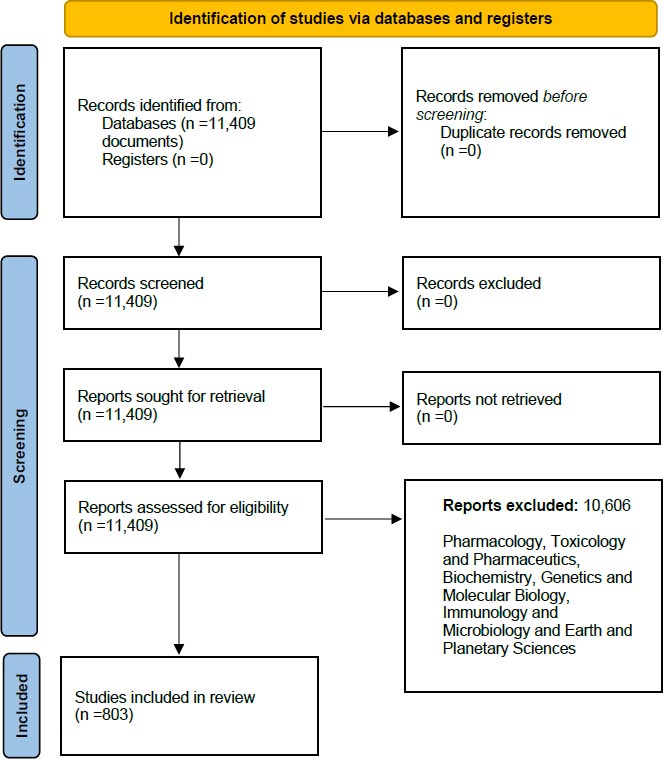 |
Fig. (1). Adapted PRISMA (preferred reporting items for systematic reviews and meta-analyses model (systematic review process). |
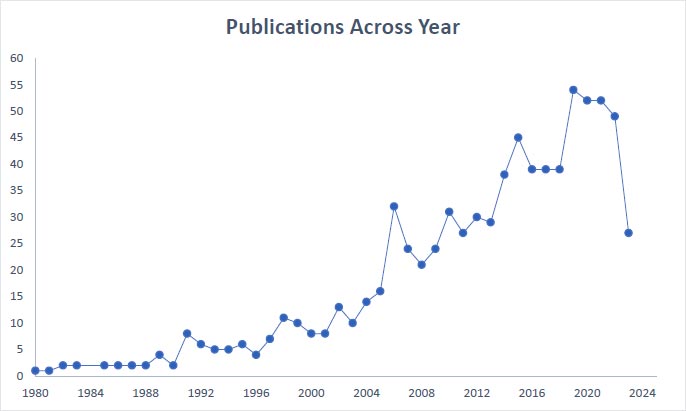 |
Fig. (2). Publication trend. |
The most important part of bibliometric data is rectifying data. The same author writing in diverse ways in different articles should be consolidated. Additionally, some words like “human” and “humans” should be treated as the same. Moreover, some general terms like “articles, article, conclusion, results” should be ignored while mining our data.
3. RESULTS
3.1. Descriptive Analysis
3.1.1. Overall Trend
The Number of papers that have been published during 43 years in hospital risk management has increased over time (Fig. 2). The annual growth rate in this field is 7.97%. It obviously indicates the peak of its publication during 2005 and 2019-2020, the time of the spread of the outbreak of SARS (SARS-CoV or SARS-CoV-1) and the coronavirus pandemic, respectively. For 43 years, the record included in our bibliometric analysis accounted for 803 documents, with 10,447 citations. All details related to citation metrics are displayed in Table 1.
3.1.2. The Most Cited Paper
The most cited articles globally and locally are shown in Table 2. The top citation paper indicates the popularity of the article which was published in 2013 written by K. Witt, R. van Dorn,and S. Fazel, “Risk Factors for Violence in Psychosis: Systematic Review and Meta-Regression Analysis of 110 Studies” [ 27] and closely followed by the paper from J.J. Waring, and S. Bishop which was about the hospital lean [ 28].
| Domain | Results |
|---|---|
| Publication Years | 1980-2023 |
| Citation Years | 43 |
| Papers | 803 |
| Citations | 10,447 |
| Cites/Year | 242.95 |
| Cites/Paper | 13.01 |
| Cites/Author | 4,481.54 |
| Papers/Author | 346.45 |
| Authors/Paper | 3.23 |
| h-index | 50 |
| g-index | 76 |
| NO. | Author | Year | Title | Source | Cites |
|---|---|---|---|---|---|
| 1 | K. Witt, R. van Dorn, S. Fazel | 2013 | Risk Factors for Violence in Psychosis: Systematic Review and Meta-Regression Analysis of 110 Studies | PLoS ONE | 405 |
| 2 | J.J. Waring, S. Bishop | 2009 | Lean healthcare: Rhetoric, ritual and resistance | Social Science and Medicine | 266 |
| 3 | P.C. Nystrom, K. Ramamurthy, A.L. Wilson | 2002 | Organizational context, climate and innovativeness: Adoption of imaging technology | Journal of Engineering and Technology Management - JET-M | 193 |
| 4 | S. Sundar, P.L. Olliaro | 2007 | Miltefosine in the treatment of leishmaniasis: Clinical evidence for informed clinical risk management | Therapeutics and Clinical Risk Management | 172 |
| 5 | J.R.P. Ogloff, M. Daffern | 2006 | The dynamic appraisal of situational aggression: An instrument to assess risk for imminent aggression in psychiatric inpatients | Behavioral Sciences and the Law | 163 |
| Rank | Author | Numbers of Paper | Country | Numbers of Paper |
|---|---|---|---|---|
| 1 | Crema, M. | 7 | United States | 229 |
| 2 | Verbano, C. | 7 | United Kingdom | 119 |
| 3 | Delcea, C. | 6 | Australia | 53 |
| 4 | Bradea, I. | 4 | Italy | 45 |
| 5 | Daffern, M. | 4 | Canada | 37 |
3.1.3. The Most Productive Author & Country, Relevant Sources
The most productive author published 7 articles and they were written by Crema, M., and Verbano, C., while the most productive countries were the USA and the UK, respectively. The details are shown in Table 3. Hospital risk management articles in the SCOPUS database are most often published in PLOS One (H index = 404, Q1), International Journal of Health Care Quality Assurance (H index = 54, Q2), Safety Science (H index = 140, Q1) which was illustrated in Fig. ( 3). These descriptive data indicated that hospital risk management research since 1980 was high quality.
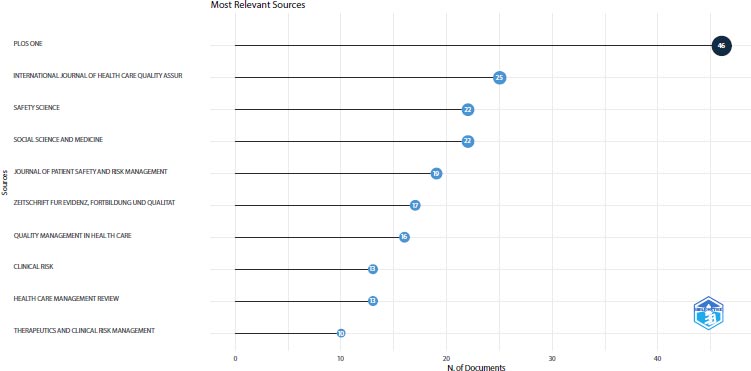 |
Fig. (3). The most relevant sources. |
| Rank | Author’s Keywords | Occurrence |
|---|---|---|
| 1 | Risk Management | 158 |
| 2 | Patient Safety | 64 |
| 3 | Risk Assessment | 32 |
| 4 | Healthcare | 19 |
| 5 | Clinical Risk Management | 16 |
| Cluster Identification | Keywords | Cluster Interpretation |
|---|---|---|
| Cluster Red | Decision-making, enterprise risk management, health & safety, hospital management, national health service, quality, risk analysis, risk assessment, risk identification | Enterprise risk management (non-clinical risk) |
| Cluster Green | Covid-19, crisis management, decision support, disaster, emergency management, healthcare, human factors, infection control | Crisis, Disaster, Emergency (Extreme Impact Risks) |
| Cluster Blue | Communicating risk, falls, incident reports, patient safety, root cause analysis, safe practice | Patient Safety |
| Cluster Yellow | FMEA (failure mode effect analysis), medication errors, quality assurance, quality improvement, quality management, risk reduction | Hospital quality system |
| Cluster Purple | Climate change, adverse events, quality control, resilience, safety management | Climate Change and Resiliency |
| Cluster Pink | Clinical risk management, health care quality, health lean management, safety culture | Clinical risk management |
| Cluster Orang | Prevention, risk perception, safety | Risk culture |
| Cluster Brown | Health services, sustainability | Sustainable Health Services |
3.1.4. Most Frequent Keywords & Trends Topics
Our team employed both VOSviewer and R program in analysing keywords and trend topics (Table 5 and Fig. 3). This paper focused on only author keywords that are represented in Table 4.
Analyzing author keywords together with trend topics (Fig. 4) conveyed more insight. Even “patient safety” and CRM keywords such as medical errors and FMEA were more frequently used keywords. Nowadays, the trend topics in hospital risk management gear towards COVID-19, disaster, resilience, and ERM, respectively. This result determines the paradigm shift of hospital risk management. Nevertheless, past, present and hotspot trends aredisplayed in the next section.
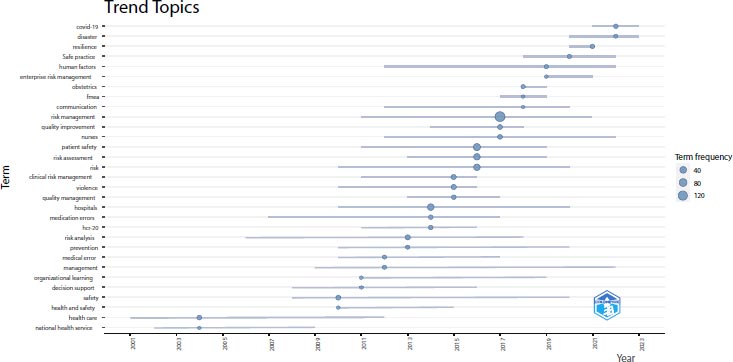 |
Fig. (4). Trend topics. |
3.2. Visualizing Hospital Risk Management Publication Theme
3.2.1. Co-occurrence and Clustering
The main objective of this work focused on research hotspots in hospital risk management for about 43 years. The first step our team considered was “co-occurrence analysis,” which conveys the fact of two or more things occurring together at the same time, or it can be called “factor analysis.” The keyword co-occurrence aims to discover two or more keywords in the same paper, which assists us in identifying the research hotspots [ 29]. This research was scoped to analyze research themes by using only “author keywords.” We did not insert “indexed keywords” into our model since it will be broad.
Fig. ( 5) represents the network visualization of author keywords. The size of the label and the circle of an item are indicated by the weight of the item. The biggest circle (cluster blue) indicates the well-known field of study. The author's keywords in this cluster are “communicating risk, falls, incident report, patient safety, root cause analysis, and safe practice.” Most of the keywords in this cluster are related to patient safety systems. Some well-known keywords such as risk assessment (cluster red), healthcare (cluster green) and CRM (cluster pink) are also interesting in academia. The initial finding shows that the hotspot trend of hospital risk management is CRM and patient safety. Certainly, each cluster in Fig. ( 5) is clustered and interpreted by expert opinion (Table 5). Some clusters are related to non-clinical risk, such as enterprise risk management, climate change and resiliency, crisis, disaster, and sustainable health services. However, they are not well-known in academia compared to CRM.
3.2.2. Thematic Map
Thematic map combines co-occurrence analysis and clustering to forecast the theme of the research landscape. Biblioshiny conducts a thematic map under to two-dimensional strategic diagram: density and centrality. The theme in the upper-right is known as the “motor theme” which represents strong centrality and high density. It means that this zone is both well-developed and important for the structuring of a research field. In Fig. ( 6), patient safety incident reports are located in this zone.
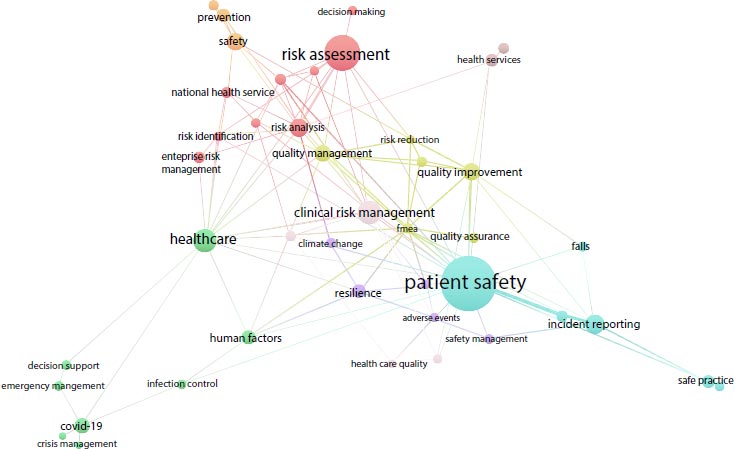 |
Fig. (5). Co-Occurrence analysis by clustering theme. |
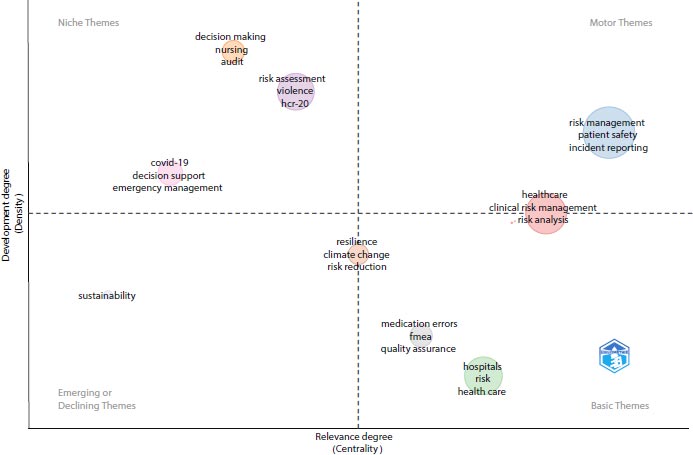 |
Fig. (6). Thematic map. |
However, the “basic theme” in the lower-right shows the relevant theme, yet it does not develop. To be more precise, this zone indicates the general concept of hospital risk management, such as quality system, FMEA, medical error and quality assurance. While the upper-left quadrant indicates the highly developed and isolated theme. Fig. ( 6) shows the isolated theme, such as COVID-19, in which it presents the emerging disease and connects with the emergency system in the hospital.
The lower-left quadrant is both weakly developed and has low centrality. It can be interpreted as both an “emerging or declining theme.” In this research, the word used in this area is “sustainability.” We then further analyzed the evolution of the author keyword across time in Fig. ( 7). The hotspot issues of hospital risk manage- ment, such as “clinical risk management and patient safety, were well-known among researchers during 2015-2017. Nevertheless, the current state and future trend of hospital risk management have geared toward “sustainability (behind health service), enterprise risk management, resilience, disaster, covid-19 (focus on the color orange to red). Therefore, Figs. ( 6 and 7 show the emerging theme of hospital risk management is shifted to “sustainable and resiliency hospital risk management.”
4. DISCUSSION
According to the descriptive analysis of publication pattern, co-occurrence of author keywords, clustering, as well as thematic analysis, the major theme of hospital risk management is still patient safety which is the goal of CRM. However, this research profiling has evolved from time to time. We gained insightful, relevant keywords, such as Enterprise Risk Management (ERM), resilience, sustainability, crisis management as well as disaster. Our team concluded past, present and future research themes in hospital risk management: 1) patient safety and CRM, 2) ERM and 3) Sustainable Hospital.
Bibliometrics text analytics precisely shows that the outstanding hospital risk management is from patient safety and CRM. A highly cited paper (Table 2) was published in PLoS one, “Risk Factors for Violence in Psychosis: Systematic Review and Meta-Regression Analysis of 110 Studies” [ 27]. This paper conducted a systematic review and meta-analysis using 6 electronic databases (CINAHL, EBSCO, EMBASE, Global Health, PsycINFO, PUBMED) and Google Scholar with its aim to identify the reported factors associated with violence in adults diagnosed. There were 405 citations in this paper. Markedly, among the researchers, most citations in hospital risk management until now are patient safety and
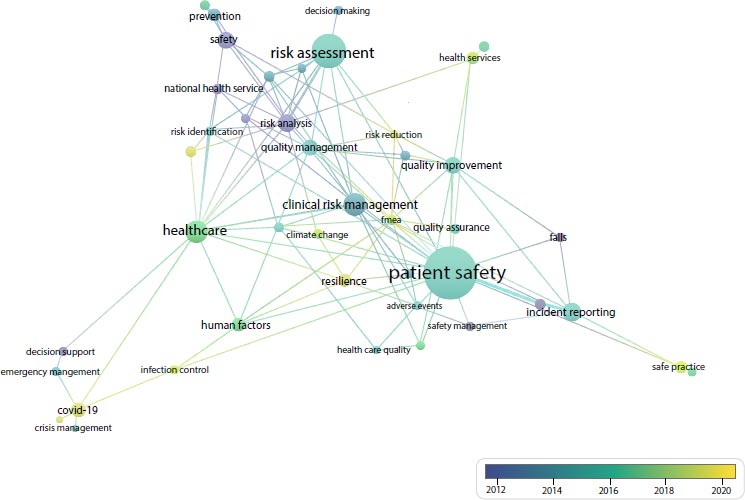 |
Fig. (7). Evolution of author keywords discussion. |
CRM. It confirms that patient safety is the main topic in hospital risk management.
However, patient safety and CRM are both operational risk management, while other types of risk should be a concern. Even the majority theme in hospital risk management in our text analytics approach indicated the high attention to clinical risk. The current hotspot theme nowadays accounts for “ERM” (cluster red in Fig. ( 5). Studying non-clinal risk is not new. One of the highly cited articles from an author [ 28], stated the lean system mentioned non-clinical risk management in hospitals; however, ERM in the hospital was not mentioned at that time.
Indeed, from 803 publications, we found 32 articles related to ERM in hospitals. There are two more citations from Etges [ 8, 9] since 2018 and 2019, respectively. Furthermore, Etges has citations in 14 articles. The first article of his team, “Development of an enterprise risk inventory for healthcare,” was published in BMC Health Services Research, 18(1). The aim of this paper was to propose ERM inventory risk to healthcare organizations by using several types of information. Additionally, the second paper was published in the Journal of Risk Research, 22(4), entitled “A proposed enterprise risk management model for health organizations.” The objective of this paper is to propose an ERM model for health organizations using a systematic review of seven case studies in Brazilian hospitals. Importantly, it concluded that studying ERM in hospitals is new and needs to be studied further.
ERM fulfills patient safety and CRM as it allows hospitals to be concerned about other important aspects. For example, inadequate medical staff risk has materialized globally, as well as the COVID situation disrupted hospitals relating to routine operations.
The thematic maps show the emerging theme of sustainability in the hospital sector in recent times. “Sustainable development” was formally established in 1987 with the concept of “the development that meets the needs of the present without compromising the ability of future generations to meet their own needs” [ 29, 30], it is now a starting point in the healthcare and hospital sector. We found only 3 documents related to “sustainable risk in hospitals” in the SCOPUS database [ 31-33].
CONCLUSION
Studying hospital risk management is not new. However, the analysis of its trend is neglected. We then explored the hospital risk management research landscape from reliable documents in SCOPUS for 43 years using bibliometric analysis. Although we decided not to include Pharmacology, Toxicology and Pharmaceutics, Biochemistry, Genetics and Molecular Biology, Immunology and Microbiology and Earth and Planetary Sciences in order to focus on risk in management view, the research profiling in this field remained “clinical risk management toward patient safety goal.”
The annual growth rate in hospital risk management publications is 7.97% and experiencing an upward trend over time. The peak of publications occurred during the spread of viruses such as SARS and COVID-19. The most productive author and highest citation conducted CRM, while the most productive country was the USA.
The common results from author keywords analysis, such as, co-occurrence and clustering, showed that the majority of hospital risk management is related to CRM aspects such as patient safety, medication error, FMEA, and so forth. However, the research themes in this field have been altered from time to time.
Bibliometric data provided some hidden insights. The main focus area is CRM, after 2020, some relevant themes were found, such as ERM, disaster, resiliency, and sustainability. The thematic analysis further confirms that the emerging theme in this field is “sustainability.”
Conducting research profiling using bibliometric analysis can generate three paradigms of hospital risk management: 1) CRM, 2) ERM and 3) sustainable risk. This article brings about two contributions. Practically, it allows the hospital management team to be concerned about related to risk aspects. In general, the risk manager often identifies risk against patient safety goals while other aspects of risk are neglected. Our bibliometric analysis closes the gap that they need to identify risk at the enterprise level as well as inclusive sustainability. Theoretically, this research initially adopts the bibliometric analysis in the risk context.
Nevertheless, this paper conveyed some limitations. Our key word analysis relied upon our search strategy. All results in this article were based on data extraction by searching. Moreover, studying hospital risk management is more than just 803 documents. There are other relevant sources, such as Web of Science, PubMed and also white papers, that this study neglected. We then proposed future studies incorporating this into their framework.
LIST OF ABBREVIATIONS
| CRM | = Clinical Risk Management |
| ERM | = Enterprise Risk Management |
| FMEA | = Failure Mode Effect Analysis |
STANDARDS OF REPORTING
PRISMA guidelines and methodologies were followed.
AVAILABILITY OF DATA AND MATERIALS
The data and supportive information are available within the article.
FUNDING
None.
CONFLICT OF INTEREST
The authors declare no conflict of interest, financial or otherwise.
ACKNOWLEDGEMENTS
Declared none.
SUPPLEMENTARY MATERIAL
PRISMA checklist is available as supplementary material on the publisher’s website along with the published article.
Supplementary material is available on the publisher’s website along with the published article.
REFERENCES
| [1] | Ferdosi M, Rezayatmand R, Molavi Taleghani Y. Risk management in executive levels of healthcare organizations: Insights from a scoping review (2018). Risk Manag Healthc Policy 2020; 13: 215-43. |
| [2] | Briner M, Manser T. Clinical risk management in mental health: A qualitative study of main risks and related organizational management practices. BMC Health Serv Res 2013; 13(1): 44. |
| [3] | Briner M, Kessler O, Pfeiffer Y, Wehner T, Manser T. Assessing hospitals’ clinical risk management: Development of a monitoring instrument. BMC Health Serv Res 2010; 10(1): 337. |
| [4] | Comite U, Dong K, Li RYM, Crabbe MJC, Shao X-F, Yue X-G. An economic–business approach to clinical risk management. J Risk Financial Manag 2020; 13(6): 135. |
| [5] | Motta Zanin G, Gentile E, Parisi A, Spasiano D. A preliminary evaluation of the public risk perception related to the covid-19 health emergency in italy. Int J Environ Res Public Health 2020; 17(9): 3024. |
| [6] | Park J, Min J, Song JH, et al. The COVID-19 pandemic response and its impact on post-corona health emergency and disaster risk management in republic of Korea. Sustainability 2023; 15(4): 3175. |
| [7] | Kielhorn T, Mccarthy BA, Shope D, et al. Enterprise risk management: Implementing ERM. 2020. Available from: www.ASHRM.org |
| [8] | Etges APBS, de Souza JS, Kliemann Neto FJ, Felix EA. A proposed enterprise risk management model for health organizations. J Risk Res 2019; 22(4): 513-31. |
| [9] | Etges APBS, Grenon V, Lu M, et al. Development of an enterprise risk inventory for healthcare. BMC Health Serv Res 2018; 18(1): 578. |
| [10] | da Silva Etges APB, Grenon V, de Souza JS, Kliemann Neto FJ, Felix EA. ERM for health care organizations: An economic enterprise risk management innovation program (E2RMhealth care). Value Health Reg Issues 2018; 17: 102-8. |
| [11] | Soltanizadeh S, Abdul Rasid SZ, Mottaghi Golshan N, Wan Ismail WK. Business strategy, enterprise risk management and organizational performance. Manag Res Rev 2016; 39(9): 1016-33. |
| [12] | Yaraghi N, Langhe RG. Critical success factors for risk management systems. J Risk Res 2011; 14(5): 551-81. |
| [13] | Zhao Y, Elahi E, Khalid Z, Sun X, Sun F. Environmental, social and governance performance: Analysis of CEO power and corporate risk. Sustainability 2023; 15(2): 1471. |
| [14] | Chairani C, Siregar SV. The effect of enterprise risk management on financial performance and firm value: The role of environmental, social and governance performance. Meditari Accountancy Research 2021; 29(3): 647-70. |
| [15] | Cohen G. The impact of ESG risks on corporate value. Rev Quant Finance Account 2023; 60(4): 1451-68. |
| [16] | Cohen G. ESG risks and corporate survival. Environ Syst Decis 2023; 43(1): 16-21. |
| [17] | Saardchom N. Enterprise risk management under sustainability platform. 2013. Available from: http://www.academicstar.us |
| [18] | Tamala JK, Maramag EI, Simeon KA, Ignacio JJ. A bibliometric analysis of sustainable oil and gas production research using VOSviewer. Clean Eng Technol 2022; 7: 100437. |
| [19] | Zhao L, Zhao Y, Du J, Desloge A, Hu Z, Cao G. Mapping the research on health policy and services in the last decade (2009–2018): A bibliometric analysis. Front Public Health 2022; 10: 773668. |
| [20] | Fusco F, Marsilio M, Guglielmetti C. Co-production in health policy and management: A comprehensive bibliometric review. BMC Health Serv Res 2020; 20(1): 504. |
| [21] | Manoj Kumar L, George RJ. P.S A. Bibliometric analysis for medical research. Indian J Psychol Med 2023; 45: 277-82. |
| [22] | Aria M, Cuccurullo C. bibliometrix : An R-tool for comprehensive science mapping analysis. J Informetrics 2017; 11(4): 959-75. |
| [23] | Haunschild R, Bornmann L, Marx W. Climate change research in view of bibliometrics. PLoS One 2016; 11(7): e0160393. |
| [24] | Liu B, Fan Y, Xue B, Wang T, Chao Q. Feature extraction and classification of climate change risks: A bibliometric analysis. Environ Monit Assess 2022; 194(7): 495. |
| [25] | Nti IK, Adekoya AF, Weyori BA, Keyeremeh F. A bibliometric analysis of technology in sustainable healthcare: Emerging trends and future directions. Decis Anal J 2023; 8: 100292. |
| [26] | Moher D, Liberati A, Tetzlaff J, Altman DG. Preferred reporting items for systematic reviews and meta-analyses: The PRISMA statement. PLoS Med 2009; 6(7): e1000097. |
| [27] | Witt K, van Dorn R, Fazel S. Risk factors for violence in psychosis: Systematic review and meta-regression analysis of 110 studies. PLoS One 2013; 8(2): e55942. |
| [28] | Waring JJ, Bishop S. Lean healthcare: Rhetoric, ritual and resistance. Soc Sci Med 2010; 71(7): 1332-40. |
| [29] | Chen S, Xu Z, Wang X, Škare M. A bibliometric analysis of natural disasters and business management in tourism. J Bus Econ Manag 2022; 23(2): 305-26. |
| [30] | Brundtland GH. Our common future - Call for action. Environ Conserv 1987; 14(4): 291-4. |
| [31] | Nagariya R, Kumar D, Kumar I. Sustainability evaluation of service supply chains: A case study of an Indian hospital. Int J Prod Perform Manag 2022; 71(7): 2865-92. |
| [32] | de Oliveira UR, Muniz MA, Anaia LA, Rocha HM. Medication supply chain risk management for a brazilian home care provider: A business sustainability study. Clean Logist Supply Chain 2022; 3: 100018. |
| [33] | Bravo AMS, Carvalho JCD. Challenging times to pharmaceutical supply chains towards sustainability: A case study application. Int J Procure Managa 2015; 8(1/2): 126-40. |









